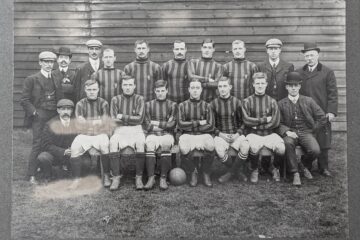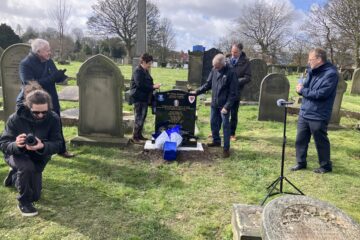
key men in the Blues’ success
EFC Heritage Society member Rob Sawyer is appealing for supporters’ memories of Everton players from a golden era.
Rob, who wrote the excellent biography of Harry Catterick, says: “My dad and I watched the Blues sweep all before them in the 1980s, but his greatest praise was reserved for the championship-winning team of 1938/39. This has inspired me to chronicle the players’ stories particularly that of Tommy ‘T.G.’ Jones, dubbed ‘The Prince of Centre- Halves’.”
Those lucky enough to see it, claim that this team best-fulfilled the School of Science billing bestowed upon the Club by former Derby County striker, Steve Bloomer. Much like in 1984, something clicked for a team that had been in a state of transition during the previous season. And, just like Kendall’s champions, the 1938/39 team was a finely-tuned mix of youth and experience, skill and steel.
Agile goalkeeper Ted Sagar was nicknamed ‘The Boss’ for the way he dominated his box. Uncompromising full-backs Billy Cook and Norman Greenhalgh struck fear into wingers like Stanley Matthews, and the three-man half- back line was the bedrock of the team.
Joe Mercer was an established England international whilst the veteran captain, Jock Thomson, contributed nous and physicality (Gordon Watson was an able deputy when called-upon). Between them strode one of Goodison’s greatest in T.G. Jones – the unflappable centre-half who combined defensive dominance with playmaking ability. The forward line was no less impressive.
Tommy Lawton, heir to Dixie Dean, bagged goals for fun. Diminutive left-flank duo Alex Stevenson and Wally Boyes tormented defenders whilst mercurial right-winger Torry Gillick could be unplayable. The industrious Stan Bentham, along with Greenhalgh the only uncapped player in the team, helped bind the team together. Interestingly, not one of the first XI was a Scouser with Bentham, from Newton le Willows, being the most local.
T.G. Jones would claim that the team was so good that it barely had to break sweat to win games. It was denied a chance to land further silverware by the seven-year hiatus in league and cup football caused by the Second World War. When peacetime competition resumed in 1946, many players were past their best whilst Lawton and Mercer soon moved on. At odds with the directors, T.G. left the Club in 1950, after 14 years’ service, to run a hotel in Pwllheli.

…………………………..
Since this article was written in 2017, Rob has witnessed the fruits of his endeavours in the publication of his biography of Tommy ‘T’.G.’ Jones, which was shortlisted in the Sports Book Awards 2018 for Best Biography of the Year.




